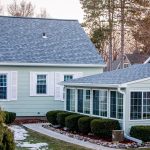
What Is a Drip Edge on a Roof & Why You Need One

A drip edge on a roof is key to prevent water damage, and is a feature you just shouldn’t skip on your roof.
Rainwater damage can silently wreak havoc, seeping into vulnerable spots and compromising structural integrity. Not only that but inadequate drainage from not having a drip edge can cause long-term costly repairs.
Simply put, a drip edge is essential for a secure, resilient roof and to win the ongoing battle with the elements.
But, there’s a bit to them than you’d might expect, so let’s dig a little deeper.
What is a roof drip edge? Our drip edge definition
A roof drip edge is a crucial metal flashing that sits on the edge of your roof, shielding your home from water damage. It acts as a protective barrier, keeping the roof deck and fascia boards safe from water infiltration, guarding against potential problems like rot and mold.
UPGRADE YOUR ROOF WITH CONFIDENCE
Protect your home with durable, high-quality roofing from Prairie Exteriors. Trusted and reliable solutions.
What does a drip edge do?
A drip edge directs rainwater away from the fascia, preventing seepage under roofing materials. Proper installation preserves your home’s integrity, ensuring the roof’s longevity. By channeling water effectively, it safeguards against structural damage, making it a vital component for any home, protecting against potential issues.
In Wisconsin and need support installing a drip edge? Click the button below to get in touch
Is a drip edge necessary on a roof?
Yes, a drip edge is vital for any roof — it guarantees your roof’s long-term strength and resilience, making it indispensable for safeguarding your home. As a professional roofing contractor, we always recommend that you have a drip edge installed, whether you’re having a new roof installed or need a replacement.
Putting in a drip edge, considering the metal roofing gauge, brings a host of benefits, making it a must-have for any roof. Here’s why having a drip edge is so crucial:
- Extends roof lifespan: By guiding water into the gutters and away from the edges of the roof, a drip edge plays a key role in preserving the roof’s materials. This not only ensures the roof’s long life but also saves you money by reducing the need for frequent repairs and replacements.
- Protects fascia and siding: Without a drip edge, water runoff has the potential to harm your home’s fascia boards and siding. They act as a shield, keeping these areas safe and intact, and preventing any damage caused by water.
- Prevents pest infestation: Having standing water near the roof’s edge can attract pests such as insects and rodents. A drip edge is crucial in preventing water buildup, decreasing the chances of pest infestation, and ensuring a healthier living environment.


- Easy gutter maintenance: Drip edges play a vital role by directing water straight into the gutters. This proper water flow simplifies gutter maintenance, making it more efficient. By preventing clogs, drip edges ensure the drainage system works seamlessly, saving homeowners from the hassle of dealing with water blockages.
- Prevents ice dam formation: Since they facilitate proper drainage from the roof, you reduce the risk of ice buildup along the roof’s edge. This minimizes the potential for water seepage and damage during the winter months, offering essential protection against weather-related issues.
Where does a drip edge go on a roof?
A drip edge is positioned along the roof’s edges, beneath the roofing material and over the deck. It extends into the gutters, facilitating smooth water flow. Placed at the eaves and rakes, its primary role is diverting rainwater away from sensitive spots, protecting the roof, fascia, and underlying structures from potential water damage.

HIGH-QUALITY
ROOF REPLACEMENT
YOU CAN RELY ON
Choose Prairie Exteriors for durable, dependable asphalt roofing solutions designed to stand the test of time.
3 Types of metal drip edge on a roof
A metal drip edge for a roof comes in different styles, each crafted to meet specific roofing needs, with the main types being:

- Type-C: Has a straight design and is typically installed on flat or low-slope roofs. It’s quite versatile and works well on different roof styles.
- Type-D: Bent in a distinctive L-shape, it’s perfect for sloped roofs, providing excellent protection against water infiltration at the roof edges. Works well on asphalt shingle roofs.
- Type-F: Stands out with its extended flange at the bottom, offering extra protection against water runoff. Particularly valuable in regions with frequent heavy rainfall, ensuring effective drainage and minimizing potential water damage.
In addition to the specific shapes mentioned above, drip edges come in specific materials, too:
- Aluminum: Being resistant to corrosion, aluminum is an excellent choice for longevity, especially if you live in a region prone to heavy precipitation. It’s also relatively affordable compared to copper drip edges.
- Copper: Some of our customers love the finish that copper adds to their rooves, but keep in mind it’s an expensive option. However, it’s durability is excellent.
- Galvanized steel: We recommend galvanized steel edges if your roof is exposed and will need to stand up to high winds; it’s also affordable.

Located in Wisconsin and Need Drip Edge Installation?
Are you in Wisconsin and in need of professional drip edge installation, specifically for metal roofing in Madison, WI?
Schedule a consultation now and safeguard your home with our reliable roofing solutions
Final points on drip edge roofing
The significance of a shingle drip edge in roofing cannot be overstated. Its pivotal role in safeguarding homes against water damage, rot, and structural decay is paramount. By effectively directing water away from vulnerable areas, a shingle drip edge ensures the longevity and durability of your roof, providing essential protection for your home.
At Prairie Exteriors, we comprehend the significance of a dependable shingle drip edge, especially for metal roofs. Investing in its proper installation and regular maintenance with reliable Wisconsin metal roof companies like Prairie ensures a dry, secure, and well-protected home.
FAQs
Is there a difference between drip edge and rake edge?
Yes, there is a difference between a drip edge and a rake edge. A drip edge runs along the eaves, guiding water into gutters. A rake edge is placed on the gables to prevent rain-driven moisture. Both are vital in protecting roofs, each addressing water management and structural integrity.
Should shingles hang over the drip edge?
Absolutely, shingles must overhand the drip edge. This ensures water flows directly into gutters, preventing seepage beneath the roof’s edge. Proper overhang safeguards the roof’s integrity, shielding it from potential damage and prolonging its lifespan while maintaining effective drainage away from the structure.
Can you install a drip edge after gutters?
Yes, you can install a drip edge after the gutters are in place, but precision is key. Professional installation ensures it’s aligned correctly and functions effectively. Retrofitting demands expertise to prevent gutter disruption. When done right, even post-gutter installation, the drip edge efficiently directs water away, safeguarding the roof’s integrity.
YOUR TRUSTED PARTNER FOR ROOF REPLACEMENT
Upgrade to a durable asphalt roof with help from Prairie Exteriors. Built to protect your home.



